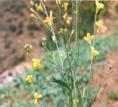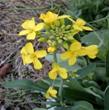AGR 301 :: Lecture10 :: RAPESEED-MUSTARD Brassicas sp.
![]()
Brassicas are grown next to peanut in India. Rapeseed-mustard is a common name to three Genera :
- Brassica
- Eruca
- Sinapsis
- Brassica is more important
Rape seed and mustard field

Importance of Brassicas in India
- It is main Rabi season crop in India
- Green tender plant is used as vegetable
- Whole seed is for preparing pickles and flavoring vegetables and curries
- Oil for cooking, frying and pickles
- Oil is also used for vegetable ghee, hair oil, soap, lubricating oil, and tanning industries
- Seed & oil have peculiar pungency
- Due to presence of glucose sinigrin
- Oil cake is a cattle feed to be fed at smaller quantity Canola
- It is a trade name to rapeseed oils which possess
- <2% erusic acid
- Solid components should contain
- <30 micromoles /g of glucosinolates
- May be Canadian oil like “Mazola” (maize oil – Corn oil), “Sanola” sunflower oil ( again brand name for PUFA content)
- Of late refers to ‘generic’ but
- Those rapeseed varieties metingabove the specification
(Erusic acid causes heart lesions and
Glucosinolates cause thyroid enlargement)
Brassicas grown in India
Taxonomic name |
Common name |
Hindi |
Oil Content |
B. Campestris |
Turnip rape |
Brown sarson |
Kali sarson |
Var. brown sarson |
Brown sarson |
Kali sarson |
43% |
Var. yellow sarson |
Yellow sarson |
Peeli sarson |
45% |
Var. toria |
Indian rape |
Toria |
35% |
B. napus |
Swede, summer, winter rape |
Gobhi sarson |
Oilseed |
B. Juncea |
Indian mustard |
Rai, Raya |
35% |
B. toumefortii |
Wild mustard |
Jungli rai |
18% |
B. carinata |
Ethiopian mustard |
Karan rai |
Oilseed |
B. nigra |
Black mustrad |
Banarsi rai |
29% Condiment |
B.Oleratea |
|
|
Vegetables |
Eruca sativa |
Rocket |
Taramira |
28% |
Rapeseed vs. Mustard
Character |
Rapeseed (Sarson/Toria/Lahi) |
Mustard |
Plant height (cm) |
45 – 150 |
90-200 |
Leaves |
Sessile, leaf lamina claps the stalk |
Leaves stalked but do not clasp |
Siliquae (pod) |
Short or thicker |
Long & slender |
Pollination |
Cross pollinated |
Self pollinated |
Seed coat |
Smooth |
Rough |
Brown sarson vs. Yellow sarson
Character |
Brown sarson |
Yellow sarson |
Leaves |
Pale, thin |
Dark green and fleshy |
Branching |
Erect, spreading |
Erect |
Siliquae (pod) |
Thin, narrow |
Thick and broad |
Seed coat |
Dark brown to reddish brown & mucilaginous |
Yellow & non mucilaginous |
Types of Mustard varieties







Origin
- Rai – China
- Toria – East Afghanistan
- Brown sarson – E. Afghanistan & adjoining Indian sub-continent
- Yellow sarson – N.E. India
Rapeseed: Area cultivated in the world (1997) – (Million ha & million t)
Country |
Area |
Production |
Productivity |
India |
7.28 |
8.13 |
1.12 |
China |
6.74 |
12.65 |
1.88 |
Canada |
5.32 |
9.11 |
1.71 |
France |
1.41 |
4.14 |
2.95 |
Germany |
1.43 |
5.34 |
3.73 |
World |
27.80 |
48.97 |
1.76 |
(FAOSTAT, 2006)
Rapeseed-Mustard – Indian Scenario
State |
Area |
Production |
Productivity (kg/ha) |
Rajasthan |
3665.3 |
4416.9 |
1205 |
UP |
790.2 |
907.8 |
1149 |
Gujarat |
338 |
456 |
1349 |
Haryana |
709 |
792 |
1117 |
MP |
809.4 |
847.5 |
1047 |
WB |
421.5 |
383 |
909 |
Assam |
212.5 |
97 |
456 |
Punjab |
49 |
54 |
1102 |
India |
7276.5 |
8131.2 |
1117 |
(Ministry of Agriculture, Govt. of India, 2005-06)
Brassicas Area in India
- Till independence area remained constant (2.0million ha)
- From 50’s area rose steadily
- Due to increase in irrigated area
- Increased productivity, varieties and agronomic practices
- Maximum area was in 6.87 million ha -96-97
- Major states growing are
- Rajasthan, UP, Gujarat, Haryana, MP, WB, Assam & Punjab
Climate
- A crop of temperate
- Can be in higher elevation of tropics
- Rabi season crop in India,
- Sep-Oct to Mar-Apr
- Temperature range 3 to 40°C
- Optimum 18-25°C with cool, dry clear weather
- High RF, high humidity, cloudy atmosphere at flowering undesirable
- Most susceptible to frost
Season
- Sowing starts from August ends in November
- Sowing of rapeseed is ahead of mustard
- Taramira is sown from mid-Sep to Oct end
- Region wise season varies
Varieties
- Mustrad
- Varuna (T 59), TM 2, TM 4, Seetha
- Brown sarson
- KNS 3, KOS 1
- Yellow sarson
- PUSA GOLD, YS 93
- Toria
- Jawahar Toria, Panchali, TS 29
- Taramira
- RTM 13, TMC 1
Soil
- Varying soil from sandy loam to clay
- Thrives well in light soil
- Mustard on any soil but rapeseed in light
- Well drained soil is more suitable
- Waterlogging should not be
- Saline alkaline soils are unsuitable
- pH 6.5 to 7.5, neutral soil is ideal
Land preparation
- Fine seed bed since seeds are small
- Flat bed to perform ferti cum seed drill
Seed rate & spacing
- 4-6 kg depending upon seed weight
- 3-5 g/1000 depending upon crop and variety
- 30 x 10 to 30 x 15cm
- 22.2 to 33.3 plants m-2
Sowing
- Treat the seeds with fungicides well before sowing
- May be behind the country plough
- Ferti cum seed drill
- Depth of sowing 3-4cm
- Avoid shallow sowing
- Cover the seeds after sowing
- Sowing may be on conserved soil moisture
Manuring
- Oil seed crops removes huge nutrients
- S is removed in large and needs return
- General recommendation varies to States
- 60-40-40 for irrigated
- Half N 30 DAS
- If SSP is applied S is taken care, if not
- 20-40kg elemental sulphur, if soil analyzed with <10ppm
- 30-20-20 for rainfed (half of irrigated)
- All basal
- Nutrient requirement may be calculated by critical concentration
- 6.07 – 6.62% N in top 2-3rd leaf at 60 DAS
- 0.408 – 0.412% S in 4-5th leaf from top
- Integration with biofertlizer ‘Azotobactor’ is desirable
Irrigation
- Total water requirement - 400mm
- Moisture at pre-flowering and pod filling stage is critical
- Two irrigations for mustard
- One at rosette stage (20-30DAS)
- Another at siliqua atage (50-60DAS)
- In light soils three irrigations, the third at 90DAS
- IW/CPE ratio of 0.6 is optimum
Weed management
- Dominant weeds
- Chenpodium album
- C. murale
- Convolvulus arvensis
- Melitotus alba
- Intercultural operation 5-10days after 1st irrigation
- Hand hoeing is desirable, it aerates the soil
- Soil aeration is to conserve soil moisture
- Herbicides can also be used
- Pendimethalin pre-emergence 0.5-1.5 kg/ha based on soil
- Fluchloralin 1.25kg pre-plant incorporation
- Post emergence Isoproturan 0.75 kg /ha for
- Wheat+mustard mixed systems
Harvesting maturity
- Color of leaves, stem and silique turn green to pale yellow
- Lower silique looks – dried appearance
- Upper may be green
- Seeds in the silique makes rattling sound
- Silique with 2 carpels and a false septum
- During over maturity the two carpels split and seeds shed
- Premature harvest leads to shriveled grains
Threshing
- After sun drying for few hours
- Beating pods along with the plants
- Either manually
- Machine
- Walking bullocks, or running tractor
- Cleaning and drying to 8-10% moisture for storage
- Average yield
- Irrigated rapeseed 1.5 to 2.0 t
- Rainfed rapeseed 1.0 to 1.5t
- Irrigated mustard 2.0 to 2.5 t
- Rainfed mustard 1.5 to 2.0t
Cropping systems
- Fallow / millets / pulses – mustard
- Rice – rapeseed
- Intercroppings
- Mustard + chickpea
- Mustard + sugarcane
- Mustard + barley / wheat / chickpea
- Potato + mustard
Multiple choice questions
- Total production of rapeseed-mustard in the world is _________m tonnes
a. 25.15 b. 35.15 c.45.15 - Total production of rapeseed-mustard in India is _________m tonnes
a. 8.15 b. 6.96 c.9.15 - The peculiar pungency of rapeseed-mustard is due to the presence of _____
a. erusic acid b. sinigrin c. Glucosinolates - Oil content of Brassica juncea is ______
a. 45 % b. 43 % c. 35 % - Oil content of Brassica campestris Var.yellow sarson is ______
a. 45 % b. 43 % c. 35 % - Oil content of Brassica campestris Var.brown sarson is ______
a. 45 % b. 43 % c. 35 % - Seed rate of rapeseed-mustard is _______ kg/ha
a. 6 - 8 b. 4 - 6 c. 2 – 4 - Spacing recommended for rapeseed-mustard is _______
a. 35 x 15 – 20 cm b. 30 x 15 – 20 cm c. 30 x 10 – 15 cm - Fertilizer dose for irrigated rapeseed-mustard is _______ kg NPK /ha
a. 60-40-40 b. 30-20-20 c. 40-20-20 - Fertilizer dose for rainfed rapeseed-mustard is _______ kg NPK /ha
a. 60-40-40 b. 30-20-20 c. 40-20-20 - Rate of sulphur recommended for rapeseed-mustard is _______ kg /ha
a. 10-20 b. 20-40 c. 30-40
| Download this lecture as PDF here |
![]()